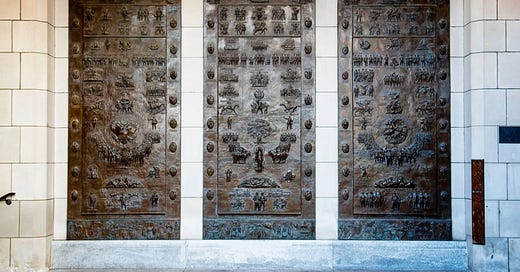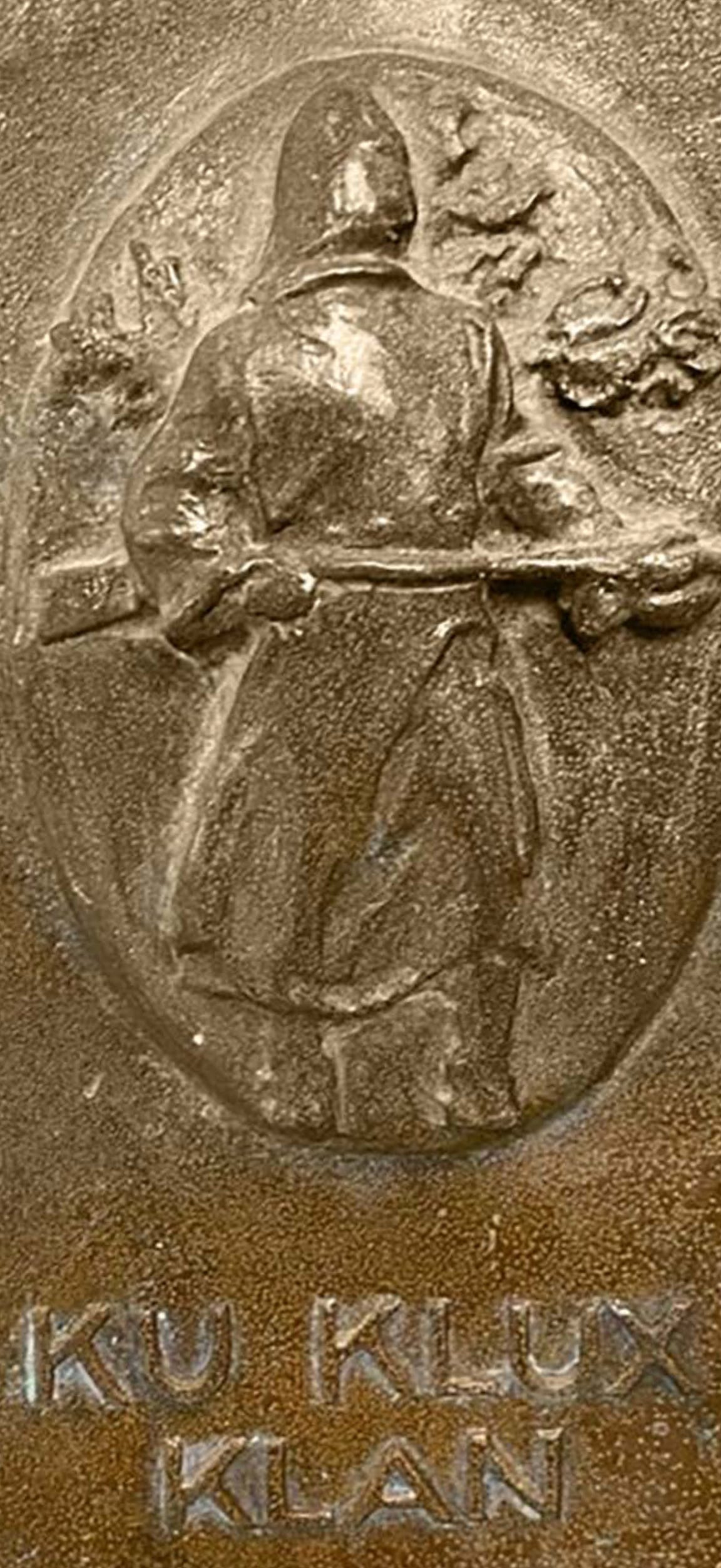Update: I have received additional information that sheds light on this marker. The image is part of a large relief that features roughly 150 additional images that reference important events and people in American history. They include John Brown, William Lloyd Garrison, Booker T. Washington, the Atomic Bomb, and the Santa Maria, among others. The relief—executed by artist Laura Gardin Fraser—was completed in 1956 and dedicated in 1965. One of her most notable projects was the statue of Robert E. Lee and Stonewall Jackson that was located in Baltimore before its removal in 2017.
West Point’s archive includes the artist’s brief notes that explain each image. The Ku Klux Klan image is described as an “organization of white people who hid their criminal activity behind a mask and sheet.” There is nothing celebratory about it and it is certainly not in any way connected to the commemoration of Confederate military leaders on campus. One of the things that I now realize is highly misleading, both in the Naming Commission’s report and in the extensive media coverage, is that there is no indication that the particular image is part of a much larger relief.
West Point’s library has digitized the artist’s description of the relief and the key to understanding the individual images.
The release of the final report from a Congressional committee (Naming Commission) assigned to look into how West Point and the Naval Academy have commemorated the Confederacy is receiving a great deal of media attention. It should come as no surprise that they are focusing much of their coverage on the discovery of a small marker located above the entrance of West Point’s science building that depicts a man in a hood holding a rifle and the words “Ku Klux Klan” below it.
Headlines such as, “K.K.K. Plague Hangs Above Entrance to West Point Science Hall” and “West Point's KKK shame” will no doubt leave readers assuming the worst about the institution and the reasons for this small marker that few people appear ever to have noticed.
But here’s the problem.
No one has been able to explain why it’s there in the first place or what it represents. Even the Naming Commission failed to offer any explanation or provide the relevant historical context for its placement in its report.
A photograph of the marker is included in their report, which is accompanied by the following caption:
The Commission visited West Point and worked closely with leaders and historians there to identify assets such as these that have clear ties to the Confederacy, while also gathering information to determine whether or not those assets fall within the Commission’s remit.
The implication, as I read this, is that the placement of the marker was part of a broader commemoration or celebration of the Confederacy and the Klan.
This wording is potentially misleading.
It isn’t clear to me at all that this is a vindication of the Confederacy or the Klan and it has troubled me ever since I wrote about it yesterday morning.
Earlier today my friend and fellow historian Mark Snell left a comment that offers one possible explanation. Mark lived and taught at West Point for a number of years and admitted that he never noticed the marker while on campus. He writes:
Since the Force Acts were implemented during the first administration of President U.S. Grant (USMA 1843), and the final of the acts, called the Ku Klux Klan Act (1871), was enforced in part by the U.S. Army, this could be the reason for the inclusion of the Klansman--a domestic terrorist and enemy of the United States--on the plaque. I'm just guessing--maybe another reader out there will have some more information.
This an interesting observation that is worth further research. For those of you who need your memory refereshed the Enforcement or Ku Klux Klan Acts were passed by the House and Senate in 1870 and 1871 in an effort to protect the civil rights and voting rights of African Americans in the former Confederacy. As many of you know violence was rampant during this period as terrorist groups like the Klan attacked and murdered scores of Black Americans.
The actions of the Grant administration effectively ended the Klan’s reign of terror.
It is possible that this marker is, in fact, intended to commemorate the US military’s role, including officers like Major Lewis Merrill, Major General Frederick Steele and others, in ending the Klan’s violence in the postwar South.
This is a reasonable interpretation. It certainly makes better sense than what is being portrayed in the media right now.
After all, I understand why West Point eventually chose to honor graduates who served in the Confederate army, but I cannot think of any reason why the institution would have honored the Klan.
Obviously, we need additional information. I have been unable to uncover anything that would provide some historical context to better understand this marker.
I will keep you updated as I learn more.





Just take it down. Who cares where it came from. But I’m sure many people were not happy with it being there. Just take it down and ship it to the nearest smelter.
Good intentions or not, I don't care. The Equal Justice Initiative estimates 4,084 lynchings in America between 1877 and 1950 (one listing has it at 4,440). The placement and meaning of this plaque at West Point will probably be dismissed as murky and unfortunate by some; however, this depends on the lens you're viewing history. I was a young child in the late 1950's - early '60's and remember my friends and I loving to play act from popular tv shows at the time: Jim Bowie, Davey Crockett, The Alamo, etc. only to find out years later the true history of these people/events. As James Baldwin once said: "As a child, you're rooting for the cowboys only to find out later that you're the Indian". This plaque may seem unfortunate by some, but slightly heartbreaking to those of us who are tired of those dismissive of the manipulation of historical facts. That plaque is there, that's a fact; intentions are feelings, not facts.